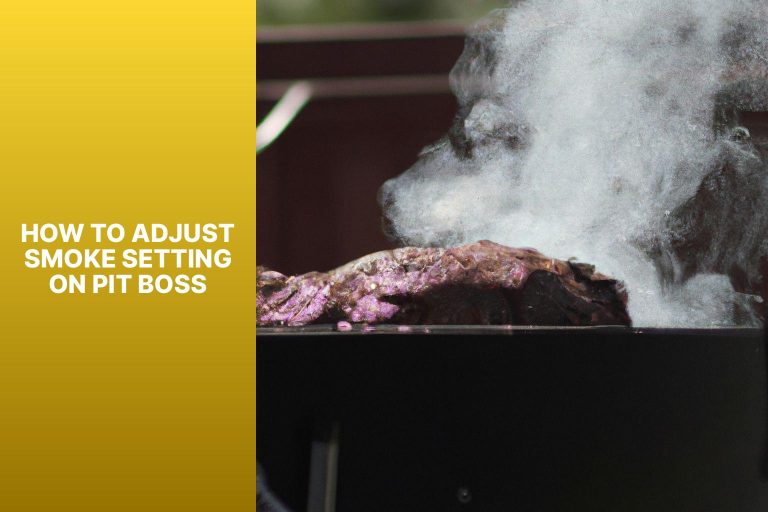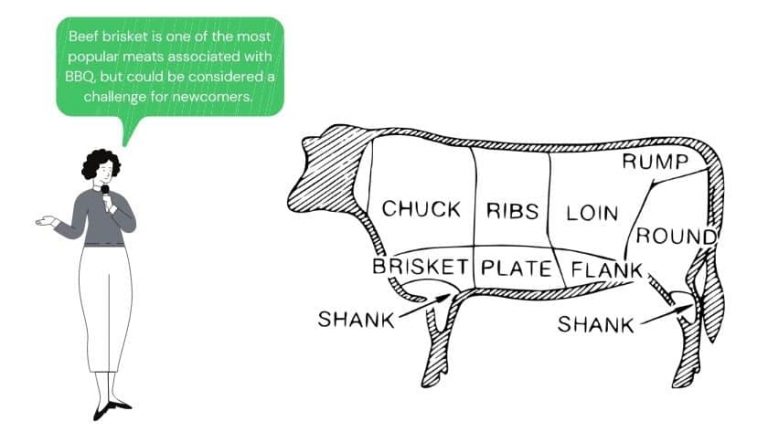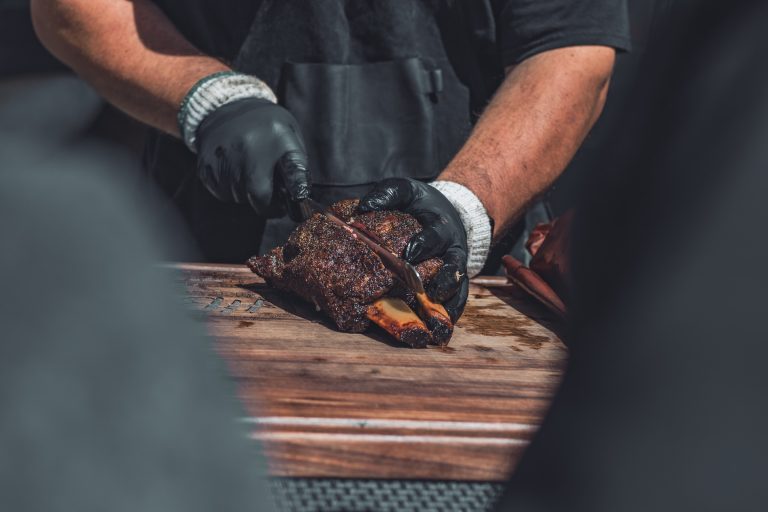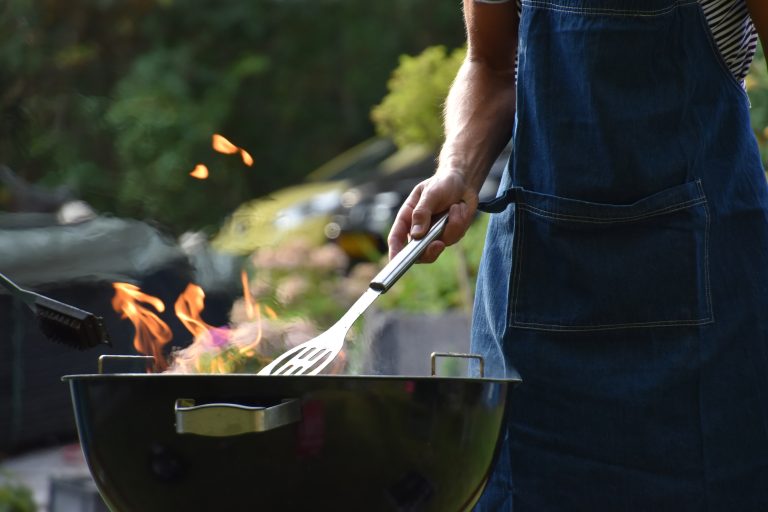Char-Broil vs Weber Gas Grill Comparison
Gas grills are not new to the barbecuing scene. Gas-fueled grills have only grown in popularity since first introduced at the World’s Fair in 1939. It wasn’t until after WWII that home grilling started to gain momentum, and in the 1950s, charcoal grills were invented.
In the 1960s, charcoal grills were redesigned to support bottled propane, which was used to persuade home grillers to switch from charcoal to natural gas.
Today, we have access to various grills and fuel sources for cooking, but gas grills have remained strong across the industry.
Char-Broil: A Brief Overview
Thought to be the first backyard grill, the Char-Broil 19 was sold at hardware stores carrying W.C. Bradley Co. agriculture and stove supplies.
The CB 19 was developed by the Bradley Co to offer outdoor cooking options for backyard leisure as the agriculture industry continued to move westward.
Available for $19, the grill was made from a steel drum that eventually included aluminum and unique add-on accessories.
As the demand for gas grills increased throughout the 1960s, Char-Broil sold units quicker than they could mass produce. Soon, the first grease-handling system was patented to make the experience safer and easier to clean.
In the 1970s, Char Broil’s first electric grill was introduced along with portable gas grills and tabletop grills.
In 1984, The CB940 was labeled the “World’s Best BBQ Grill,” in 1999, the Patio Bistro won the Honorable Mention Award, and in 2000 Char-Broil was the winner of the Golden Hammer Award.
In the early 2000s, Char-Broil partnered with Thermal Engineering Corp to include infrared technology in their grills to directly heat food being cooked instead of relying only on the movement of hot air like convection ovens.
By 2013, Char-Broil had won five more awards, including the Gold Medal Honor for the TRU-Infrared gas grill.
Weber Grill: A Brief Overview
In 1952, Weber created its first domed shape charcoal grill. The dome lid was a design that solved so many environment-related issues for outdoor grilling that hadn’t been addressed yet.
While other grills on the market were excellent when they worked, none had lids to protect either the food or the grill from rain, snow, animals, or excessive smoke.
Now being advertised with a cover, Weber paved the way for future grill masters and backyard feasts.
Since its introduction the company has committed to the round dome shaped Weber grill. In the 1970s, an ad campaign stated, “the unique dome shape reflects the heat evenly all around, just like a kitchen oven.”
It has since been proven the round shape does not reflect the heat better than its square or rectangular competitors. Still, Char-Broil remained true to their signature design and focused on product efficiency using air dampers and grate positioning.
In 1985, Weber launched a gas grill, the Genesis. A gas kettle grill from Weber was already on the market, but the round shape was already associated with charcoals, and the kettle grill never took off.
The Genesis changed that as gas grilling was in high demand, and Weber fans were now more open-minded to give it a try. The Genesis line also opened the doors for colored gas grills and porcelain-enamel lids.
In 1989, the Weber Grill Restaurant was opened in Wheeling, Illinois. Four other locations opened in 1999, 2002, 2005, and 2007.
Introductory Line Comparison


Char-Broil Performance 300 vs. Weber Spirit II E-210
Cooking Area:
- Char-Broil Performance 300: This grill comes with 300 square inches of primary cooking space and 100 square inches of additional space for warming.
- Weber Spirit II E-210: The E-210 gas grill has a large cooking area composed of 360 square inches of primary cooking space and 90 square inches of warming space for a total of 450 square inches.
Feature and Functionality:
- Char-Broil Performance 300: The 300 comes with porcelain-coated cast-iron cooking grates, two stainless steel burners, a stainless steel lid, two folding side shelves, four casters, an electronic ignition, a grease pan, and a storage cabinet with a tank holder. With the turn of a valve, push of a button, and knob-controlled flame height, all that’s left is to heat up and add the meat.
- Weber Spirit II E-210: This grill can put out the heat with only two burners. Using the GS4 grilling system, porcelain-enameled Flavorizer bars, porcelain-enameled cast-iron cooking grates, an Infinity ignition, and grease management, you only have to choose which color is your favorite out of the four available. The sleek design of this model can make any neighbor jealous.
Build Quality:
- Char-Broil Performance 300: Cast iron grates, porcelain coating, a large drip pan, an enclosed and fully supported firebox, protected propane tank storage, a stainless steel lid, and weighing 82.5 pounds gives the 300 a durable body and stand that will not easily fall over or apart.
- Weber Spirit II E-210: Cast iron, porcelain-enameled, stainless steel parts, triangular Flavorizer bars, burner protection for reduced flare-ups, stainless steel burners, a grease management system, and weighing 103 pounds, this grill is tough to beat in the build category.
Power and Heat Retention:
- Char-Broil Performance 300: The Char-Broil has two burners and two-zone cooking. Grilling, slow roasting, and high-temperature searing are easily accomplished on the Performance 300. It takes approximately 15 to 20 minutes to preheat on high. Heat retention is not an issue with this grill, and each burner produces 12,000 BTUs.
- Weber Spirit II E-210: The Weber grill has two burners for dual zone cooking. Each burner puts out 13,250 BTUs. Allowing direct and indirect heat, this grill heats up quickly, maintains heat, and can offer slow roasting or quick searing for preferred cuts of meat.
Accessibility and Storage Space:
- Char-Broil Performance 300: The product dimensions for the Performance 300 are 44″ high, 42.9″ wide, and 24″ deep. Using a closed cabinet for storage and two folding shelves, this grill can save space when not being used and protect tools and a tank from environmental factors.
- Weber Spirit II E-210: The product dimensions for the Spirit II are 44.5″ high, 48″ wide, and 27″ deep. This model uses an open cabinet feature for easy accessibility. There are six hooks for hanging grilling tools and when not in use, the side shelves can be folded for space-saving. The tank hook acts as a fuel gauge for easy reading.
Mid-Range Line Comparison


Char-Broil Performance 475 vs. Weber Spirit II E-310
Cooking Area:
- Char-Broil Performance 475: The 475 provides a total of 660″ of cooking area. There are 500″ of primary cooking and 160″ of cooking space on the side burners and drying rack.
- Weber Spirit II E-310: The E-310 from Weber has a combined total of 529″ cooking space between the primary grilling area and a warming rack.
Feature and Functionality:
- Char-Broil Performance 475: Char Broil’s Performance 475 model has four porcelain-coated stainless steel burners, side burners, a grease pan, and cast-iron grates for even cooking. The closed cabinet offers protected storage, and four hidden casters provide a sleek appearance. One-touch ignition is used to start the grill.
- Weber Spirit II E-310: There are three burners, reversible porcelain-enameled cast-iron grates, an externally stored propane tank that is mounted on a fuel gauge for easy reading, an open cart design, two side shelves with one that is foldable, and six integrated hooks that are featured on the E-310.
Build Quality:
- Char-Broil Performance 475: With a stainless steel build, stainless steel burners, porcelain-coated cast-iron grates, and heavy-duty casters, the body of this grill is sturdy and durable. The power of the burners only adds to the unit’s general appeal.
- Weber Spirit II E-310: The Weber Spirit is built with high-quality materials that ensure a solid and durable unit. Stainless steel, porcelain-enameled cast iron, a removable grease tray, and an easy-to-clean design come together to provide any grill master a unique experience.
Power and Heat Retention:
- Char-Broil Performance 475: The porcelain-coated grates help retain the heat on the cooking surface and in the cooking chamber. The main four burners produce 36,000 BTUs, and the side burner puts out another 10,000.
- Weber Spirit II E-310: While only having three burners in the primary cooking chamber, the BTU difference between the Char-Broil Performance 475 and Weber Spirit II E-310 is only 6,000. That number is quite impressive. Porcelain-enameled cast-iron grates offer excellent heat retention and performance.
Accessibility and Storage Space:
- Char-Broil Performance 475: The product dimensions for the 475 are 45″ high, 53.1″ wide, and 24.5″ deep. This grill is larger than the Performance 300 but will fit nicely on a patio, deck, or larger-sized balcony. The propane tank can be stored in the double-door enclosed cabinet along with other grilling tools and accessories.
- Weber Spirit II E-3310: The open cabinet design of the E-310 allows easy access to grilling tools, accessories, the propane tank, and monitoring the propane left with an easy-to-read fuel gauge. The six integrated hooks are beneficial while grilling and maintaining cleanliness and organization. With one side shelf that can be folded down, the Weber can be stored in smaller locations than the Char-Broil Performance 475.
Final Verdict: Which is Better?
Overall, all four gas grills are excellent at providing delicious tasting meals. After comparing all the specs, stats, pros, and cons of each grill, Weber keeps coming out on top.
Char-Broil offers an exceptional experience that is not to be overlooked, but Weber won this comparison based on versatility, size, power, and unique features.
Related Post To Consider
Best Portable Pellet Grill For Camping BBQ
Why Do Smoked Foods Last Longer? | Explained
Asmoke Vs Traeger Portable Grill ( Imp Features Compared )
Pit Boss vs. Oklahoma Joe’s: Pellet Grill Feature Comparison






